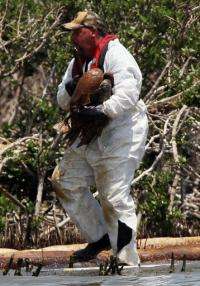BP sucking up half of oil leaking from Gulf well

Engineers hoped Monday to make more headway in their bid to contain a massive oil spill in the Gulf of Mexico after energy giant BP announced it was now capturing about half of the oil gushing from its ruptured well.
Amid the largest environmental disaster in US history, BP's chief executive Tony Hayward said a cap fitted on the leaking pipe a mile (1,600 meters) down on the sea bed appeared to be working.
"As we speak, the containment cap is producing around 10,000 barrels of oil a day to the surface," he told the BBC Sunday.
The US official in charge of the government operation, Admiral Thad Allen, agreed with the estimate, but refused to be drawn on what percentage of the leaking oil it represented.
BP said a new containment effort would be launched, involving feeding pipes into the leaking blow-out preventer that could siphon more oil.
Hayward said the system could be ready by next week and, despite criticisms of his handling of the disaster, said he had the "absolute intention of seeing this through to the end."
Government scientists have estimated that up to 19,000 barrels a day could be spewing into the Gulf since the April 20 explosion sank the BP-leased Deepwater Horizon rig just off the Louisiana coast.
"We're not going to know how much oil is coming out until we're able to optimize the production, and that's what they're doing right now," Allen told ABC television.
"They are slowly raising production. It was 6,000 a day before and it was 10,000 yesterday," he told CNN.
He warned that the Coast Guard and clean-up teams were fighting an "insidious enemy" as they battle to keep the oil from reaching the shores, amid fears Florida's beaches could be badly hit with tar balls already washing up in Mississippi and Alabama.
Florida Governor Charlie Crist said he hoped the impact on his state would not be as severe as the oozing, toxic soup the Deepwater Horizon oil spill has created in marshlands further west.
"It is easy to clean up off the beaches, as we were able to do this past weekend in Pensacola. We were disappointed that it came on the beach at all but able to clean it up fairly rapidly," he told CNN.
"It is much more difficult is what we have seen in Louisiana, when it gets into the marshes and the estuaries, once it gets in there, it is very difficult to clean up."
The Deepwater Horizon response team has launched an oil-slick monitoring plan with vessels along the Florida Keys and Dry Tortugas islands to detect oil and dispersants that threaten the coral reefs and wildlife preserves on the island chain.
So far, there are no signs of the oil in southern Florida, but experts said edges of the massive plumes were reaching the Loop Current and even the Gulf Stream that could sweep the pollution by Florida and along the eastern coast of the United States.
The slick has now spread around a 200-mile (320-kilometer) radius from the fractured wellhead, but has broken into smaller spills. "It's not a monolithic spill. It is literally hundreds of thousands of smaller spills," Allen explained on ABC.
Pictures of birds smothered in thick layers of oil have shown the impact of the disaster.
Massive spreads of boom have been deployed to protect coastlines, with Canada sending another 3,000 meters to the United States on Sunday, but in many places it has proved ineffective.
Around 660 kilometers (410 miles) of boom, mostly from private oil company stock, have been deployed to contain the spill in the Gulf of Mexico, according to US government figures.
As of Saturday, 57 "visibly oiled" birds have been found dead, and another 156 oiled birds have been discovered alive, according to figures from the government and boatmen, biologists and rescuers at Grand Isle.
Among them are the brown pelican -- the Louisiana state symbol, which was only removed from the endangered list in November.
Allen warned that regardless of how much oil is now being contained, the leak will not be completely stopped until BP completes the drilling of two relief wells, sometime in August.
"There will be oil out there for months to come," he told CBS television. "This spill is keeping everybody hostage."
The latest containment effort involves a cap placed over a sawn-off pipe, which gathers the oil, allowing it to be siphoned up to a container ship.
It was the first maneuver to demonstrate some success at curbing the amount of oil spewing into the Gulf, after a series of embarrassing failures.
(c) 2010 AFP


















